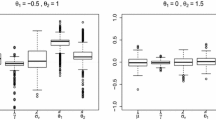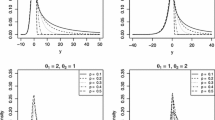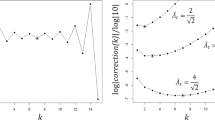Abstract
As one can see in many previous well-known papers, an one–factor stochastic volatility model has its limitation to fit the market dynamics. Based on empirical facts that the market volatility can be well explained by the combination of short-term and long-term volatilities, a multi–scale stochastic volatility model that is governed by two factors evolving on different time-scales: a fast mean-reverting factor and a persistent, slow mean-reverting factor is applied to capture the dynamics of two assets in this paper. The validity of the model was tested by calibration against the market return distribution of the S&P 500 and Dow Jones Industrial Average Indices. Based on this multiscale model, an analytically approximate formula, in terms of the Gaussian copula, was obtained for the joint transition density and the parameters of this density were estimated using daily data from the S&P 500 and DAX Indices.





Similar content being viewed by others
References
Adrian, T., & Rosenberg, J.. (2008). Stock returns and volatility: Pricing the short-run and long-run components of market risk. The Journal of Finance, 63(6), 2997–3030.
Cameron, A. C., Li, T., Trivedi, P. K., & Zimmer, D. M. (2004). Modelling the differences in counted outcomes using bivariate copula models with application to mismeasured counts. The Econometrics Journal, 7(2), 566–584.
Chernov, M., Gallant, A. R., Ghysels, E., & Tauchen, G. (2003). Alternative models for stock price dynamics. Journal of Econometrics, 116(1–2), 225–257.
Choe, H. J. Ahn, C. Kim, B. J., & Ma, Y.-K. (2013). Copulas from the fokker–planck equation. Journal of Mathematical Analysis and Applications, 406(2), 519–530.
Christoffersen, P., Jacobs, K., & Mimouni, K.. (2010). Volatility dynamics for the s &p500: Evidence from realized volatility, daily returns, and option prices. The Review of Financial Studies, 23(8), 3141–3189.
Deng, G. (2020). Pricing perpetual american floating strike lookback option under multiscale stochastic volatility model. Chaos, Solitons & Fractals, 141, 110411.
Fouque, J.-P., Papanicolaou, G., Sircar, R., & Solna, K. (2003). Multiscale stochastic volatility asymptotics. Multiscale Modeling & Simulation, 2(1), 22–42.
Fouque, J.-P., & Hu, R. (2020). Multiscale asymptotic analysis for portfolio optimization under stochastic environment. Multiscale Modeling & Simulation, 18(3), 1318–1342.
Fouque, J.-P., & Zhou, X. (2008). Perturbed gaussian copula. In Econometrics and Risk Management, (pp. 103–121). Emerald Group Publishing Limited.
Gallant, A. R., Hsu, C.-T., & Tauchen, G. (1999). Using daily range data to calibrate volatility diffusions and extract the forward integrated variance. Review of Economics and Statistics, 81(4), 617–631.
Garcia-Jorcano, L., & Muela, S. B. (2020). Studying the properties of the bitcoin as a diversifying and hedging asset through a copula analysis: Constant and time-varying. Research in International Business and Finance, (pp. 101300).
Guegan, D., & Zang, J. (2009). Pricing bivariate option under garch-gh model with dynamic copula: application for chinese market. The European Journal of finance, 15(7–8), 777–795.
Jeon, J., Kim, G., & Huh, J. (2021). Consistent and efficient pricing of spx and vix options under multiscale stochastic volatility. Journal of Futures Markets, 41(5), 559–576.
Kim, S.-W., & Kim, J.-H. (2019). Variance swaps with double exponential ornstein-uhlenbeck stochastic volatility. The North American Journal of Economics and Finance, 48, 149–169.
Kim, J.-H., Ma, Y.-K., & Park, C. Y. (2016). Joint survival probability via truncated invariant copula. Chaos, Solitons & Fractals, 85, 68–76.
Ma, Y.-K. (2015). Modeling the dependency structure of integrated intensity processes. PLoS ONE, 10(8), e0134992.
Ma, Y.-K., & Kim, J.-H. (2010). Pricing the credit default swap rate for jump diffusion default intensity processes. Quantitative Finance, 10(8), 809–817.
Meneguzzo, D., & Vecchiato, W.. (2004). Copula sensitivity in collateralized debt obligations and basket default swaps. Journal of Futures Markets: Futures, Options, and Other Derivative Products, 24(1), 37–70.
Necula, C. (2010). Modeling the dependency structure of stock index returns using a copula function approach. Romanian Journal of Economic Forecasting, 13(3), 93–106.
Øksendal, B. (2003). Stochastic differential equations. In Stochastic differential equations, (pp. 65–84). Springer.
Yang, B.-Z., Xiaoping, L., Ma, G., & Zhu, S.-P. (2020). Robust portfolio optimization with multi-factor stochastic volatility. Journal of Optimization Theory and Applications, 186, 264–298.
Zhang, K.-S., & Zhao, Y.-Y. (2021). Modeling dynamic dependence between crude oil and natural gas return rates: A time-varying geometric copula approach. Journal of Computational and Applied Mathematics, 386, 113243.
Funding
The work of Yong-Ki Ma was supported by the National Research Foundation of Korea (NRF) grant funded by the Korean government (MSIT) (No. 2021R1F1A1048937).
Author information
Authors and Affiliations
Corresponding author
Ethics declarations
Conflict of Interest
The authors declare that they have no conflict of interest.
Additional information
Publisher's Note
Springer Nature remains neutral with regard to jurisdictional claims in published maps and institutional affiliations.
Appendices
Appendix A. Correlation Between \(X_t^{(1)}\) and \(X_t^{(2)}\) Under the Model (2.2)
From the product rule for Itô Processes and the model dynamics given in (2.1) and (2.2),
To derive \(\mathbb {E}[f_1(X_s, Y_s)f_2(X_s, Y_s)]\), assume that the OU process as follows:
where \(\kappa \), \(\nu > 0\) and \(W_t\) is a standard Brownian motion. Then, it is known that
where Z is a standard normal random variable. Therefore, \(\alpha Y_t +\beta Z_t\) can be expressed as
where \(Z_1\) and \(Z_2\) are standard normal random variables with the correlation \(\rho _{YZ}\).
Now, since \(\alpha Y_t + \beta Z_t \sim N(\mu ,\sigma ^2)\),
where
Finally, the correlation Corr between \(X_t^{(1)}\) and \(X_t^{(2)}\) is derived as
Appendix B. Proof of Theorem 3.1
Applying the expansion (3.2) with \(j=0\) to (3.3) leads to
From the \(\mathcal {O} \big ( \frac{1}{\epsilon } \big )\) term in (5.1), we have a differential equation \(\mathcal {L}_{0}u_{0,0}=0\) for \(u_{0,0}\). Note that the operator \(\mathcal {L}_{0}\) is the generator of the OU process \(Y_{t}\). If we impose a growth condition on \(u_{0,0}\) such that the partial derivative \(\frac{\partial u_{0,0}}{\partial y}\) does not grow as much as
then the solution \(u_{0,0}\) must be a constant with respect to the y variable; \(u_{0,0}=u_{0,0}(t,x_{1},x_{2},z).\) Next, From the \(\mathcal {O} \big ( \frac{1}{\sqrt{\epsilon }} \big )\) terms in (5.1) and the \(y-\)independence of \(u_{0,0}\), we have
Then again if it is assumed that \(\frac{\partial u_{1,0}}{\partial y}\) does not grow as much as \(e^{y^{2}/2}\) as y goes to infinity, \(u_{1,0}\) is also independent with respect to the y variable; \(u_{1,0}=u_{1,0}(t,x_{1},x_{2},z).\) Therefore, the first two terms \(u_{0,0}\) and \(u_{1,0}\) do not depend on the stochastic volatility’s current level y of the fast-scale volatility driving the process \(Y_{t}\). Throughout this paper, all the terms of the expansions are assumed to have a reasonable growth condition such that they do not grow as much as \(e^{y^{2}/2}\).
Now, the terms of order \(1,\sqrt{\epsilon },\epsilon , and \cdots \) can continue to be eliminated. From the \(\mathcal {O}(1)\) terms in (5.1), we get \(\mathcal {L}_{0}u_{2,0}+\mathcal {L}_{1}u_{1,0}+\mathcal {L}_{2}u_{0,0}=0\). This PDE becomes
due to the y-independence of \(u_{1,0}\). This is a Poisson equation for \(u_{2,0}\) with respect to the operator \(\mathcal {L}_{0}\) with the source term \(\mathcal {L}_{2}u_{0,0}\). Then, Lemma 1 applied to (5.3) leads to (3.6).
Appendix C. Proof of Theorem 3.2
The \(\mathcal {O}(\sqrt{\epsilon })\) terms in (5.1) lead to \(\mathcal {L}_{0}u_{3,0}+\mathcal {L}_{1}u_{2,0}+\mathcal {L}_{2}u_{1,0}=0\), which is a Poisson equation for \(u_{3,0}\) the centering condition of which is given by
Meanwhile, from PDEs (3.5) and (5.3) we get
for an arbitrary function c(t, x, z) that is independent of the y variable. Plugging (5.5) into (5.4), we derive a PDE for \(u_{1,0}\) as follows:
Then, we obtain the result of Theorem 3.2 by direct computation.
Appendix D. Proof of Theorem 3.3
To obtain another first-order correction term, it is necessary to consider another singular perturbation problem (3.4). Expansion (3.2) with \(j=0\) and \(j=1\) applied to (3.4) leads to
By multiplying (5.6) by \(\epsilon \) and then letting \(\epsilon \) go to zero, we find the first two leading-order terms as follows:
Because the operator \(\mathcal {L}_{0}\) is the generator of the OU process \(Y_{t}\), \(u_{0,1}\) (the solution of \(\mathcal {L}_{0}u_{0,1}=0\)) must be a constant with respect to the y variable. Because \(\mathcal {M}_{3}\) has a derivative with respect to the y variable and \(u_{0,0}\) does not rely on y, we obtain \(\mathcal {M}_{3}u_{0,0}=0\). Moreover, because each term of \(\mathcal {L}_{1}\) has a derivative with respect to y, \(\mathcal {L}_{1}u_{0,1}=0\) holds. Thus, the equation \(\mathcal {L}_{0}u_{1,1}+\mathcal {L}_{1}u_{0,1}=-\mathcal {M}_{3}u_{0,0}\) reduces to \(\mathcal {L}_{0}u_{1,1}=0\), meaning that \(u_{1,1}\) does not depend on the y variable. Hence, the two terms \(u_{0,1}\) and \(u_{1,1}\) do not depend on the current level y of the fast-scale volatility driving process \(Y_{t}\); \(u_{0,1}=u_{0,1}(t,x_{1},x_{2},z)\) and \(u_{1,1}=u_{1,1}(t,x_{1},x_{2},z)\). In this way, it becomes possible to continue to remove the terms of order 1, \(\sqrt{\epsilon }\), \(\epsilon \) and others. For the order-1 term, we have \(\mathcal {L}_{0}u_{2,1}+\mathcal {L}_{1}u_{1,1} +\mathcal {L}_{2}u_{0,1}=-(\mathcal {M}_{1}u_{0,0}+\mathcal {M}_{3}u_{1,0})\). This PDE becomes \(\mathcal {L}_{0}u_{2,1}+\mathcal {L}_{2}u_{0,1}+\mathcal {M}_{1}u_{0,0}=0\) due to the y-independence of \(u_{1,0}\) and \(u_{1,1}\). This is a Poisson equation for \(u_{2,1}\) with respect to the operator \(\mathcal {L}_{0}\) in the y variable, which has a solution only if \(\mathcal {L}_{2}u_{0,1}+\mathcal {M}_{1}u_{0,0}\) is centered with respect to the invariant distribution of \(Y_{t}\). Because \(u_{0,0}\) and \(u_{0,1}\) do not depend on the variable y, we have
Then, we obtain the result of Theorem 3.3 by direct calculation.
Rights and permissions
About this article
Cite this article
Kim, SW., Ma, YK. & Necula, C. Modeling Tail Dependence Using Stochastic Volatility Model. Comput Econ 62, 129–147 (2023). https://doi.org/10.1007/s10614-022-10271-5
Accepted:
Published:
Issue Date:
DOI: https://doi.org/10.1007/s10614-022-10271-5
Keywords
- Rolling window methodology
- Multiscale stochastic volatility
- Perturbation theory
- Gaussian copula
- Joint transition density




